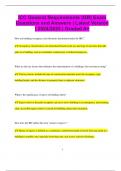ICC General Requirements (GR) Exam
Questions and Answers | Latest Version
| 2024/2025 | Graded A+
How are building occupancy classifications determined under the IBC?
✔✔ Occupancy classifications are determined based on the use and type of activities that take
place in a building, such as residential, commercial, or industrial purposes.
What are the key factors that influence the determination of a building's fire-resistance rating?
✔✔ The key factors include the type of construction materials used, the occupancy type,
building height, and the distance to property lines or adjacent structures.
What is the significance of egress in building safety?
✔✔ Egress refers to the path occupants can use to exit a building in an emergency, and ensuring
clear, accessible egress routes is crucial for building safety and evacuation.
How does the IBC define the term "means of egress"?
✔✔ Means of egress is defined as a continuous, unobstructed path of travel from any point in a
building to a public way, typically involving exits, exit access, and exit discharge.
1
,What is the purpose of fire-rated assemblies in building design?
✔✔ Fire-rated assemblies are used to prevent the spread of fire and smoke between
compartments, providing time for occupants to evacuate and for firefighting efforts.
How is the height and area of a building regulated under the IBC?
✔✔ The height and area of a building are regulated based on its occupancy type, construction
classification, fire-resistance ratings, and proximity to other structures.
What is the role of a building official in enforcing the IBC?
✔✔ A building official is responsible for reviewing plans, conducting inspections, and ensuring
that construction projects comply with the IBC and local regulations.
Why is accessibility important in building codes?
✔✔ Accessibility ensures that buildings are usable by all individuals, including those with
disabilities, by providing features such as ramps, elevators, and accessible restrooms.
What is the purpose of structural load calculations in building design?
✔✔ Structural load calculations ensure that buildings can safely support all anticipated loads,
including dead loads, live loads, wind, seismic, and snow loads.
2
, How do the IBC regulations address the installation of fire protection systems?
✔✔ The IBC requires that fire protection systems, such as sprinklers and alarms, be installed
according to occupancy type, building size, and local fire code requirements.
What factors must be considered when determining the location of fire extinguishers in a
building?
✔✔ Factors include the type of occupancy, the size of the building, the layout of rooms, and the
distance to potential fire hazards, ensuring that extinguishers are readily accessible.
What are the requirements for smoke detection systems in residential buildings under the IBC?
✔✔ Smoke detection systems must be installed in sleeping areas, in hallways outside sleeping
rooms, and on every level of the residence, with interconnection between detectors.
How does the IBC address seismic design requirements for buildings?
✔✔ The IBC requires that buildings in seismic zones be designed to resist seismic forces, with
structural systems, foundations, and connections strengthened to prevent collapse.
What is the significance of wind load considerations in building design?
3





